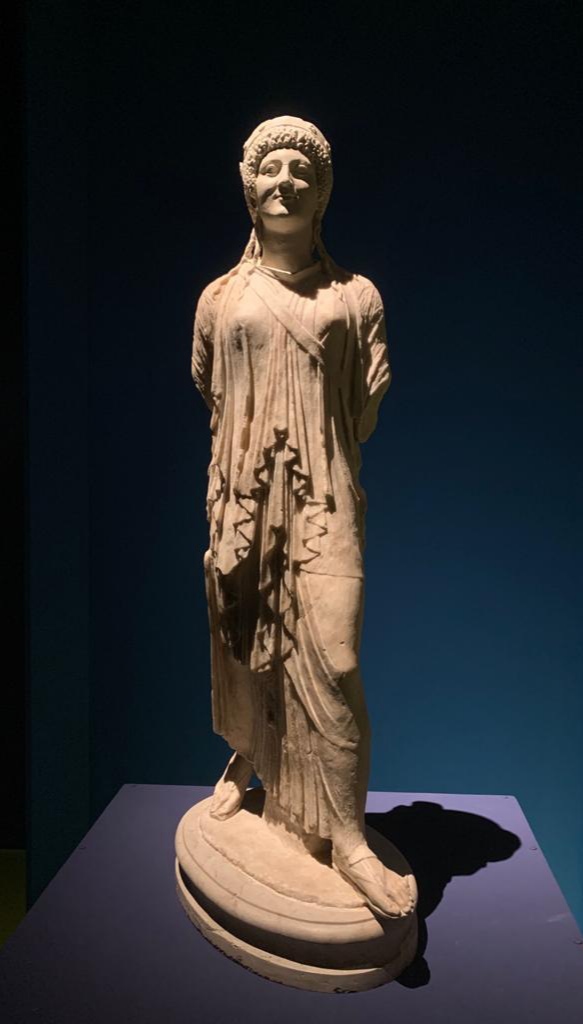
Marbles and digital clones
The Archaeological Museum elsewhere
On the occasion of the statue of Artemis loan to the Archaeological and Art Museum of Maremma in Grosseto, the National Archaeological Museum of Venice wanted to fill this absence within its collection, showing a digital clone. The latter narrates the formal changes of the artefact through a video created in collaboration with the Iuav University of Venice.
For the relief operations of the statue and head, replaced at the beginning of the 20th century and kept in storage until now, we used indirect methodologies, typical of digital photogrammetry, and software based on Structure from Motion (SfM) algorithms. Starting from a sequence of photographic images acquired with a Nikon D800E full-frame digital camera, two numerical models mapped with high-resolution textures were generated. The polygonal mesh of the stone body, obtained in a digital environment, was then the object of anastylosis operations to separate the different anatomical parts added in different periods, restoring the original shape of the sculpture that belonged to the Grimani family following historical and iconographic sources.
Given the anthropomorphic nature and the complexity of the geometric surfaces, it was necessary to control carefully vertices, edges, and faces, analyzing and promptly modifying each portion involved in the sectioning action of the parts.
Taking into account the signs of discontinuity of the polygonal surface, we identified and digitally separated three elements in the statue of Artemis: the plaster head, attributable to the de-restoration by Gerardo Ghirardini and Giuseppe Pellegrini in 1909, a portion of the left foot and the base. To facilitate an understanding of the aesthetic and morphological transformations undergone over the centuries, we simulated a game of disassembly and reassembly of the various parts using 3D animation.
In a few minutes, the sequence of images progressively illustrates the formal mutations of Artemis: from the current configuration, after a complete rotation around its axis, an anatomical decomposition process begins, which reveals the nature of the original find – a headless female bust with further removals, especially in correspondence with the right upper limb and left foot. Subsequently, it highlights the Renaissance completion that provides for the insertion of a head from a different era, the addition of the missing portion of the foot and the base. Finally, it repositions the 20th-century head, a plaster cast that imitates the Artemis kept in the National Museum of Naples, closing the narrative with the image of the goddess as it is shown today in the National Archaeological Museum of Venice.
The video demonstrates that the application of digital technologies makes it possible to intervene on the statues non-invasively to highlight the signs of breakage, the stratifications, and the reworking of ancient marbles, providing a more in-depth knowledge of our artistic and cultural heritage.
The digital support, especially in its three-dimensional declination – in the presence or, as in this circumstance, the absence of the artwork – favors a greater critical analysis of archetypes lost or changed over time, but also their enhancement, promotion, and use in the exhibition context.
Gabriella Liva, Massimiliano Ciammaichella
Università Iuav di Venezia
Memorandum of understanding between the Iuav University of Venice and the Regional Directorate of Museums of the Veneto, to activate forms of collaboration in order to develop and promote research on the theme: The statuary of the National Archaeological Museum of Venice. Digitization project, graphic rendering and exhibition. Project managers: Massimiliano Ciammaichella and Daniele Ferrara.
Research grant 2019-21, The statuary of the National Archaeological Museum of Venice. Digitization project, graphic restitution and exhibition; research fellow: Gabriella Liva, scientific supervisors: Massimiliano Ciammaichella and Monica Centanni.
Seminar 2023, Stratifications Of Memories. Exhibition Scenarios and Digital Narratives, curated by Gabriella Liva, Massimiliano Ciammaichella, Aula Magna, Tolentini, Iuav University of Venice, 4 May 2023.
To know more:
Liva Gabriella (2021). Digital identities. Technologies for the Conservation, Reconstruction and Fruition of the Sculptural Heritage/Identità digitali. Le tecnologie per la conservazione, ricostruzione e fruizione del patrimonio scultoreo. In DisegnareCon, vol. 14, n. 27.
Ciammmaichella Massimiliano, Liva Gabriella (2021). Machines For Thinking And Bodies To Preserve. Exhibition Proposal For The Venice National Archaeological Museum. In Scires-it.
Ciammmaichella Massimiliano, Liva Gabriella (2021). Mutant Bodies. Statue Digitization and Exhibition at the National Archaeological Museum of Venice. Editorial Team: Cristiana Bartolomei, Alfonso Ippolito, Simone Helena Tanoue Vizioli (a cura di). Digital Modernism Heritage Lexicon. Chan: Springer.




